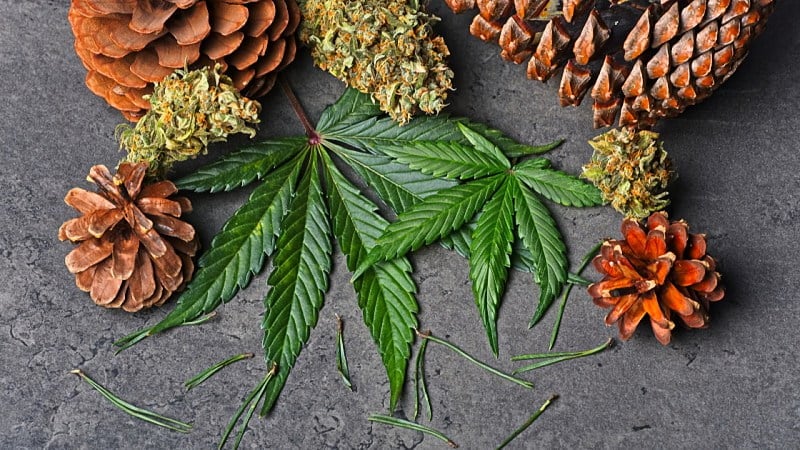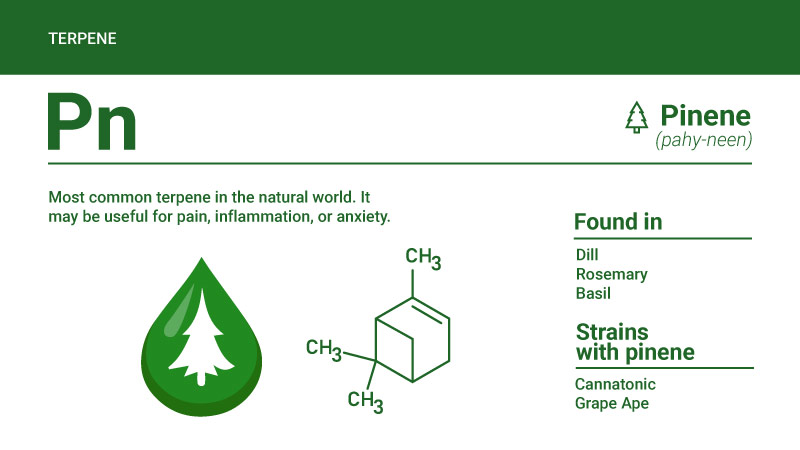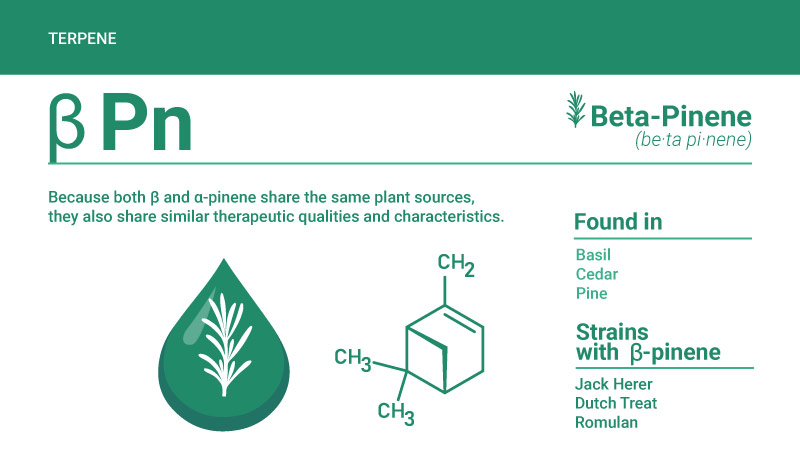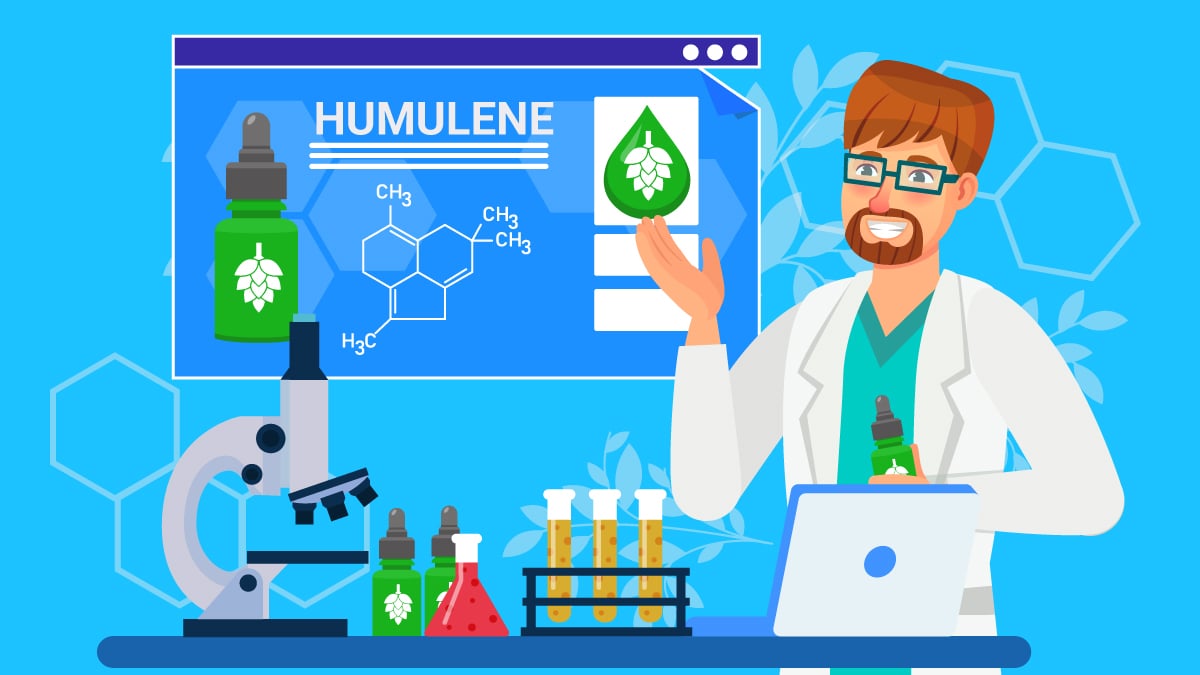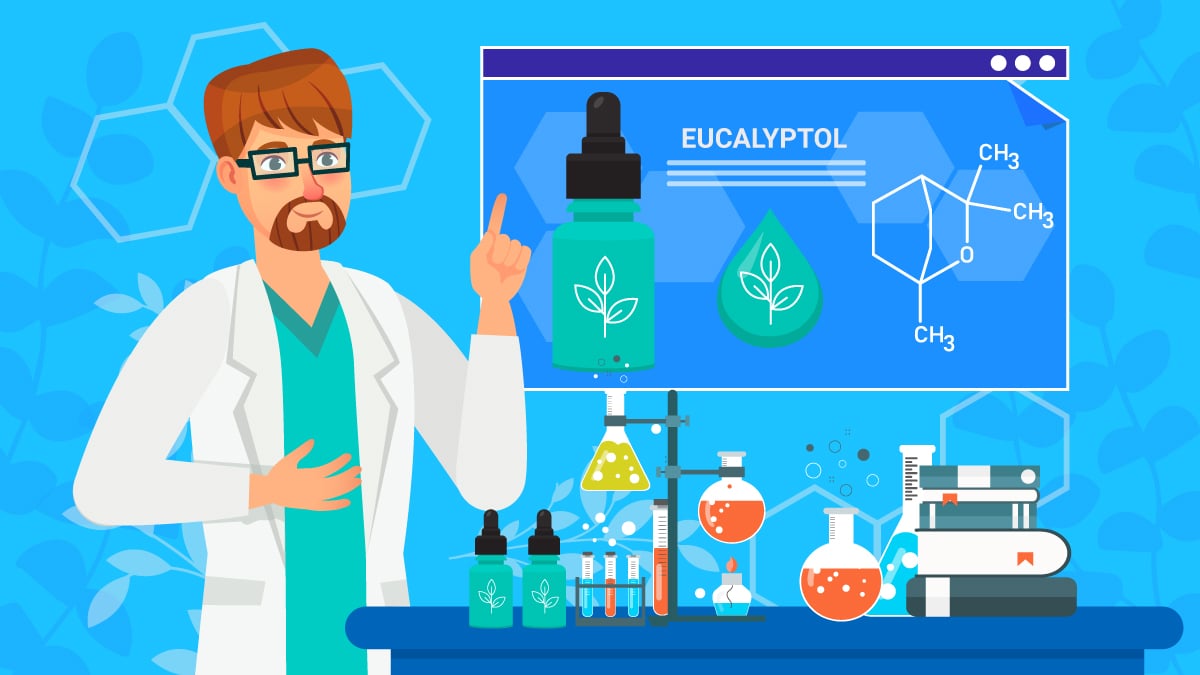Pinene Terpene: Strains, Effects, Dosage, & More
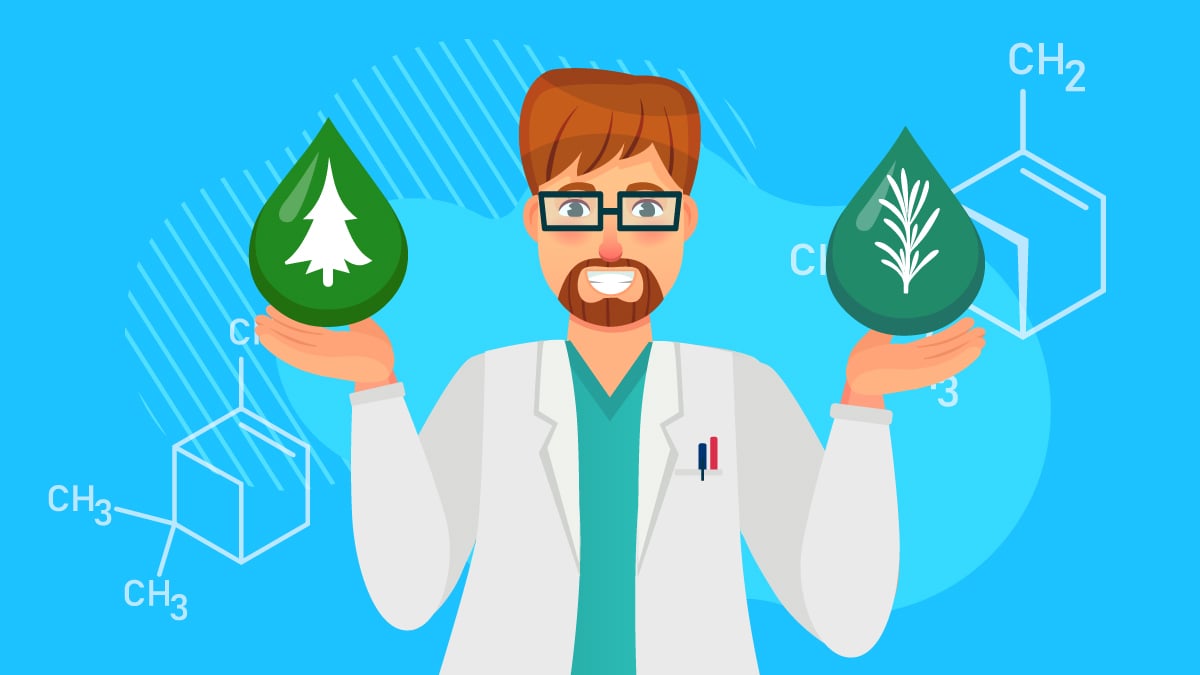
Alpha-pinene and beta-pinene are two forms of pinene — which is the compound responsible for the characteristic aroma of the pine tree (and many other conifers). It’s also one of the primary terpenes in cannabis.
In this article, you’ll learn everything about the health benefits of this terpene and how it can interact with cannabinoids to create a unique set of therapeutic effects.
What is Pinene?
Pinene is one of the simplest terpenes in existence. It consists of two isoprene units stuck together in a ring structure.
Despite its simple structure, this compound has been shown to offer a wide variety of benefits. Its most common use is in cleaning products (such as Pinesol) for sterilizing and cleaning various surfaces.
One remarkable potential use of pinene is as a biofuel in spark-ignition engines. This is caused by a-pinene dimer, which has volumetric heating values that score as high as rocket fuel.
Researchers from the Georgia Institute of Technology and Joint Bio-Energy Institute have obtained pinene synthetically by using a bacterium, as reported by a 2014 article from the American Chemical Society [1].
Related: What is a Terpene?
What’s the Difference Between Alpha & Beta Pinene?
Alpha-pinene and beta-pinene are simply two variations of pinene. The only difference between these two compounds is the base molecule’s particular class of chemicals (alkene).
Alpha-pinene is the more prevalent type; it occurs in cannabis and is the most abundant terpene found in nature.
Scientists have been studying the effects of alpha-pinene and beta-pinene for neurodegeneration-related health concerns.
What Does Pinene Smell Like?
Not all terpenes smell according to their names, but pinene is a dead giveaway. Most often, you’ll find it in the needles of the pine tree, but pinene is also found in a range of herbs and spices, which we’ll cover later in the article. The smell of pinene is very refreshing and redolent of a pine forest.
What Are the Effects of Pinene?
Aside from delivering the distinct forest-like aroma, pinene has several therapeutic properties, including:
- Anti-inflammatory Effects
- Neurological Support
- Antimicrobial Activity
Pinene has nootropic benefits by improving blood flow to the brain and blocking an enzyme known as acetylcholinesterase.
Herbs that are rich in pinene are often added to respiratory tonics.
Delta 8 THC oils with a high pinene content tend to have energizing, mood-enhancing, and neuroprotective benefits.
What Plants Contain Pinene?
Alpha-pinene and beta-pinene occur in a wide range of cannabis strains, but there are also other plants abundant in this terpene, including:
- Basil
- Dill
- Cannabis
- Parsley
- Rosemary
- Pine
- Spruce
- Juniper
One particularly enjoyable way to reap the benefits from pinene is to practice “forest breathing,” a popular Japanese activity known as shinrin-yoku. It is also one of the main activities of German complementary medicine.
The air in forests contains high levels of terpenes such as pinene. Therefore, walking and exercising there can potentially provide therapeutic benefits. It’s not surprising that this activity is fantastic for your health, considering the awe of being immersed in nature.
How Common is Pinene in Cannabis?
Since alpha-pinene and beta-pinene are so distinctive and abundant in many cannabis strains, the best rule to identify high-pinene strains is to follow your nose.
Otherwise, below we list a few strains that contain high levels of this versatile terpene:
- Blue Dream
- Cannatonic
- Grape Ape
- Harlequin
- Shark Shock
- Pineapple Express
- Citrus Sap
- Double Dream
- Vanilla Kush
- Critical Cheese
- Frank’s Gift
- Cherry Limeade
- White Fire OG
- Blue Haze
- Blueberry
Looking for cannabis strain terpenes? Check out our terpenes line up here.
Pinene Research
Similar to other terpenes, pinene has a range of potential benefits, including anti-inflammatory, antimicrobial, and neuroprotective effects.
A 2014 study published in the Journal of Natural Products concluded that pinene has anti-inflammatory effects on human chondrocytes (cells responsible for cartilage production). The authors noted that pinene inhibited the formation of compounds such as interleukin-beta. Alpha-pinene was the most effective form of this terpene (2).
In a 2012 study posted by the journal Molecules, the research team investigated the effects of pinene on various bacterial cultures. They found that pinene was toxic to Candida albicans, which trigger yeast infections [3].
Pinene also exerted bactericidal actions on methicillin-resistant Staphylococcus aureus (MRSA). Furthermore, it improved the efficacy of the antibiotic ciprofloxacin on these dangerous bacteria. Again, it was the alpha-pinene that proved the most effective.
A 2016 study published in Zeitschrift fur Naturforschung found that pinene had a two-fold antioxidant effect. Firstly, it blocked the production of harmful molecules called reactive oxygen species (ROS).
Secondly, it boosted the expression of several natural chemicals, such as [4]:
- Catalase (CAT)
- Glutathione peroxidase (GPx)
- Glutathione reductase (GR)
- Heme oxygenase 1 (HO-1)
The study’s authors concluded that pinene could positively affect the body’s neurochemical balance, translating to a delayed onset of neurological health problems.
Chemical Structure of Pinene
There are two main forms of pinene, each with some slight differences in terms of their structure and specifications.
Both forms of pinene are classified as monoterpenes, which are the simplest category of terpenes aside from isoprene — which is the base unit that forms all terpenes.
As a monoterpene, alpha- and beta-pinene are structurally similar to borneol, camphene, citral, P-cymene, delta-3-carene, eucalyptol, fenchol, geraniol, geranyl-acetate, isopulegol, limonene, linalool, myrcene, ocimene, phellandrene, sabinene, terpineol, terpinolene, and many others.
Alpha-pinene Specs:
- IUPAC Name: 2,6,6-trimethylbicyclo[3.1.1]hept-2-ene
- Molecular Formula: C10H16
- Molecular Weight:136.23
- Boiling Point: 313.2F
Beta-Pinene Specs:
- IUPAC Name: 6,6-dimethyl-2-methylidenebicyclo[3.1.1]heptane
- Molecular Formula: C10H16
- Molecular Weight:136.23
- Boiling Point: 330.8F
Does Pinene Get You High?
No, pinene won’t get you high because it doesn’t bind to cannabinoid receptors in the brain as THC does. Pinene may slightly enhance your mood by delivering energizing and uplifting effects, so the user may be under the impression that they’re experiencing slight euphoria. However, this feeling is nowhere near the signature cannabis high.
For that reason, we say that terpenes and other cannabinoids are psychoactive — because they indirectly affect your mood and behavior — but they aren’t intoxicating.
Interestingly, terpenes such as pinene can significantly contribute to the entourage effect in cannabis. In his 2011 article, Taming THC, neuroscientist and cannabis expert Dr. Ethan Russo, discussed several potential benefits of pinene. He outlined pinene’s bronchodilating and antibacterial effects, suggesting that it can also bolster the same properties in THC [5].
In the entourage effect, some cannabis compounds can counteract the adverse reactions of others. This is true for pinene and THC. Pinene has been found to inhibit the action of the neurotransmitter acetylcholine, which affects different functions in the body. It increases attention and alertness and plays an important role in learning and memory.
By slowing the breakdown of acetylcholine, pinene can mitigate some of the side effects of THC, such as short-term memory impairment. Respectively, cannabis strains high in pinene are less likely to trigger the above effect.
Related: Do Terpenes Get You High?
Summary: What Makes Pinene Special
Terpenes such as pinene play an important role in determining the therapeutic effects of different cannabis strains. They can enhance the positive effects of cannabinoids and reduce the incidence of experiencing adverse reactions. This synergistic interaction is known as “the entourage effect” and explains why whole flowers and full-spectrum extracts are considered superior to isolated compounds in the cannabis space.
Pinene comes with various potential benefits, including antioxidant, antimicrobial, and neuroprotective properties. It may also help mitigate the short-term memory impairment that many people experience when using THC in high concentrations.
Another benefit of high-pinene cannabis products is that they taste amazing. They deliver a fresh, herbal flavor redolent of a pine forest, so the next time you’re searching for the best delta 8 vapes or tinctures, look for products infused with this terpene.
References:
- Sarria, S., Wong, B., García Martín, H., Keasling, J. D., & Peralta-Yahya, P. (2014). Microbial synthesis of pinene. ACS synthetic biology, 3(7), 466–475. https://doi.org/10.1021/sb4001382
- Rufino, A. T., Ribeiro, M., Judas, F., Salgueiro, L., Lopes, M. C., Cavaleiro, C., & Mendes, A. F. (2014). Anti-inflammatory and chondroprotective activity of (+)-α-pinene: structural and enantiomeric selectivity. Journal of natural products, 77(2), 264–269. https://doi.org/10.1021/np400828x
- Rivas da Silva, A. C., Lopes, P. M., Barros de Azevedo, M. M., Costa, D. C., Alviano, C. S., & Alviano, D. S. (2012). Biological activities of α-pinene and β-pinene enantiomers. Molecules (Basel, Switzerland), 17(6), 6305–6316. https://doi.org/10.3390/molecules17066305
- Porres-Martínez, M., González-Burgos, E., Carretero, M. E., & Gómez-Serranillos, M. P. (2016). In vitro neuroprotective potential of the monoterpenes α-pinene and 1,8-cineole against H2O2-induced oxidative stress in PC12 cells. Zeitschrift fur Naturforschung. C, Journal of biosciences, 71(7-8), 191–199. https://doi.org/10.1515/znc-2014-4135
- Russo E. B. (2011). Taming THC: potential cannabis synergy and phytocannabinoid-terpenoid entourage effects. British journal of pharmacology, 163(7), 1344–1364. https://doi.org/10.1111/j.1476-5381.2011.01238.x
